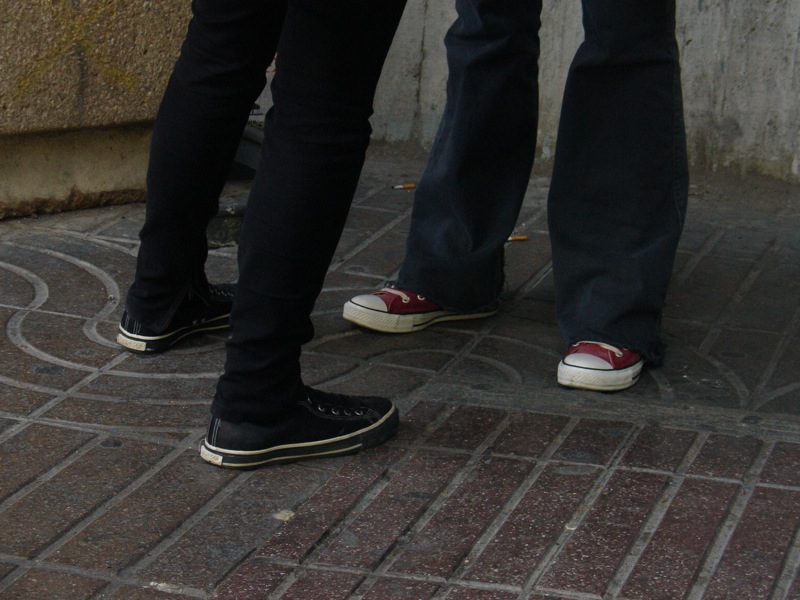Conflict Resolution: A manual for inclusive resistance, social justice and environmental defense groups
/Conflict resolution is a process using the principles of non-violent communication in which we explore the competing needs that lead to arguments, tension and conflict among people.
In Extinction Rebellion, we are working together toward the same goal. But we may have different ideas of how to do that. Some of us may be focused on our particular tasks and not realize that our actions somehow interfere with the tasks of other rebels. We may find ourselves in a situation where resources we need are scarce. Sometimes another rebel may cause another’s needs to go unmet, usually unintentionally.
Creative Commons image by charlieCe of Flickr.com
This is how conflict arises in all activist and volunteer groups. It is inevitable. We have learned from generations of civil disobedience and non-violent protest movements around the world that internal conflict is the single greatest threat to our movements, much more destructive than any outside hostile force. Most non-violent protest movements that fail collapse or gradually decline, due to internal conflict.
And yet, we have also learned from experience that suppressing conflict, pretending it isn’t there, smoothing it over or forcibly shutting it down do not work. In the long-run, suppressed conflict returns in one form or another and the longer it simmers, the more disruptive it becomes.
Therefore, we must find ways to resolve conflict which actually mitigate harm to all. The key to that kind of resolution is recognizing and meeting everyone’s needs to the best of our ability. Conflict resolution is the process of understanding and then meeting those needs, so that conflict dissipates rather than simmering or disrupting.
What standards guide conflict resolution?
We developed this guide for Regenerative Culture workers in Extinction Rebellion in the Czech Republic but it can be used effectively by anyone working in community, social or volunteer organizations. Here are some principles and standards that will help.
We recognize that conflict is inevitable. There is no need for shame or blame when conflict arises. Non-violent communication is the primary tool in conflict resolution.
If it is necessary to intervene with someone who is behaving in a disruptive or abusive manner, we do not confront this person in public online spaces. We use the non-violent communication process to address the problem directly and openly either in person, if at all possible, or in private messages, if a personal meeting is impossible.
If a conflict between two or more rebels affects the group or threatens to harm a group, the conflict resolution process is open to the group. Conflict that affects the group’s functioning is not a private matter. It affects us all.
Conflict resolution can be carried out within a local group or a working group autonomously using this handbook and non-violent communication skills. If a conflict resolution team is available to mediate, mediation may be called for.
We are committed to confronting elements of the toxic system which cause harm to vulnerable groups. If a conflict involves social exclusion, bullying, racism, misogyny, ableism, nationalism, homophobia or other manifestations of toxic social systems, we take this into account and confront these systems and their residues in ourselves.
Mediation will favor more socially vulnerable persons, if there is an accusation of harassment or bullying.
What practical guidelines will help ensure these standards?
Review and renew your group’s principles and values against discrimination/oppressive behaviors and for inclusion, equality and ethics. Hearing this announced to the group periodically has been proven in studies to decrease incidence of harassment as well as social exclusion in groups. It also makes vulnerable demographics feel welcome and safe.
Make clear at the start of trainings and intermittently in meetings that non-violent communication ought to be used and is part of your commitment to non-violence.
Review and renew your shared vision. In Extinction Rebellion, we are all fighting for our lives. When we have conflict between us, it is crucial to take a moment to bring forward the awareness that the person or people standing on the other side of the tension from me are fighting for their lives as well, possibly in a different way or with different priorities or communication/work styles.
Encourage short feedback loops in listening - feeding back in real time something that you had a reaction to, e.g. ‘It sounded to me as though your tone was a little tense just then. Is that correct/is everything OK?’ or ‘I don’t like it when you call me that - I feel very uncomfortable when this interaction happens,’ as long as these remain within the non-violent communication structure of observation without evaluation and statements of feelings in reaction.
Encourage a “step forward/step back“ attitude - taking personal responsibility and self awareness, making space for others to speak/be seen when one has been prominent for whatever reason OR challenging ourselves to speak up if we don’t usually.
NO GOSSIP policy: NO conflicts to be taken on social media at any point.
There are two processes for conflict resolution
Process ONE is for situations in which all participants in a conflict can meet.
Process TWO is for situations in which participants cannot meet because it would not be safe and there is a risk of harm to someone.
Process ONE
This is a Clearing Process for dealing with conflict--mutual or highlighted by one party. This requires both parties and a facilitator to be in the same space and only works if all participants agree to follow the process and bring good intention and a listening ear.
Agree a time and comfortable space to meet, agree on length of process and make sure you have everything you need, e.g. water, tissues etc
Use I statements and allow time for reflection and pauses in process.
Step 1: Setting up the atmosphere and intention
All participants to share some element of gratitude, e.g. ‘the sunshine on my walk here’
All participants to share their intentions - how they will conduct themselves through the process and how they’d like to feel at the end, e.g. ‘I will try and listen with an open mind and I’d like to feel at peace with you/this situation and be able to work well together’
Step 2: Seeking unity on the Facts:
One or the other party in a conflict may volunteer to go first. If an accusation is at the center of the conflict, the accuser should generally go first. If it is difficult to agree who should go first, flip a coin.
Person A shares their perception of the facts of what happened, the time, context, content etc. What would a video camera have observed? (No interruptions beyond reminders to avoid evaluation or judgmental terminology. Time limits may be set and may be amended if there is need.)
Person B does the same.
Facilitator: Observe where the facts are the same and where they are different. Acknowledging that two different perceptions may both be honest and authentic. We perceive differently from different perspectives.
Step 3: Awareness of feelings
Person A shares when they first felt negative emotions in the interaction, e.g. “when you said, xyz I felt angry.” Ask person A to try and go deeper into what is under the initial reaction ‘under the anger, I felt undermined/afraid.’ Get to the most basic feeling.
Remind participants that the fact that someone feels something is a fact. The feeling is indisputable and does not imply blame. We are ultimately responsible for our feelings ourselves. Empathy lies in acknowledging the difficulty others experience when they feel negative feelings.
Peron B reflects back, e.g. “I hear that you felt angry when I said xyz and below the anger you felt that I was undermining you and you were afraid.”
Any clarification needed?
Peron B can then share how they feel in that moment in regards to what A has shared and how they felt during the triggering interaction.
Person A reflects back what they have heard. Any clarification?
Ask both participants to reflect silently or openly if they wish on previous experiences when they felt the same difficult emotions they experienced in this interaction. How is the situation different this time?
Ask both participants if they want to ask for forgiveness for any hurt that was caused, any action that was out of alignment with that person’s good intentions, any ripple effects that came from that person's words/actions.
Step 4: Awareness of needs
Both participants now reflect and share needs, e.g. “I need time and attention to take a breath before responding in the heat of the moment, I need reassurance that my work is valued, I need to clear boundaries to feel safe in interactions.”
Guide participants to break down their needs to universal human needs, rather than requests for specific actions at this time. “Reassurance” is a universal human need. “For you to reassure me” is a specific request.
Each participant reflects back what they have heard the other participant needs. The needs are statements of fact. That a person has a universal human need isn’t disputable.
Needs may conflict. It is not automatically the responsibility of the other party to meet the needs spoken. Solutions may begin to become apparent at this stage though. We resolve conflict by first developing empathy by understanding each other’s perceptions and feelings and by finding creative solutions in which everyone’s needs are met.
Step 5: Making requests
Personal A may have requests of the other person, eg “Would you be willing to…” Requests may attempt to find a way to ensure that needs will not conflict.
Person B may agree or say, ‘No, but I could do …’ also with meeting the needs of all in mind. Note that self-sacrificing so that one’s own needs are overly delayed will likely not be sustainable.
Person B may have requests, also begining with the word, “Would you be willing to…”
Person A may agree or offer a different solution.
Step 6: Finding resolution
Review action points that A and B are taking away.
Agree on times for A and B to check in again soon.
A and B reflect on how they feel at the end of the process and what they take away from it. Give gratitude as appropriate.
Check in with A and B later to make sure the follow up check in between them happens. Some issues may require another cleaning process, if something new has arisen.
Process TWO
In case of individual feeling unsafe to go through Clearing Process with other person present this procedure for dealing with cases of harassment, bullying or unwelcome behavior is in place.
If a complaint of harassment, bullying, ostracism or unwelcome behavior is brought to the attention of the Conflict Resolution Team, prompt action must be taken to investigate the matter and action taken to remedy the complaint.
Anyone who wishes to make a complaint of harassment, bullying or unwelcome behavior is encouraged to first discuss matters with someone who they trust, ideally a Group Coordinator or someone from the Regenerative Culture Group. This is to take some time to get clear on what happened and how to engage with the process, e.g. finding a facilitator to hold the Clearing Process and approaching the other person to see if they will engage with process
If the person feels unable/unsafe to sit in the Clearing then the advocate can approach them on the complainant’s behalf. The complainant does not need to prove they are unsafe. However, complaints should be clear and specific, when brought to Process 2. Counseling may be sought from the Regenerative Culture group in order to clarify complaints.
It may be possible in this way to resolve the issue by getting the individual(s) in question to see how their behavior could be classed as harassment or bullying and to agree to desist from that behavior. Very often people are not aware that their behavior is unwelcome or misunderstood and an informal discussion can lead to greater understanding and agreement that the behavior will cease. Complainants are therefore encouraged to try, if they feel able to do so, to resolve the problem informally by making it clear to the alleged harasser that their actions are unwanted and should not be repeated.
An individual, who is made aware that their behavior is unacceptable, is asked to:
Listen carefully to the complaints and the particular concerns raised;
Respect the other person’s point of view; everyone has a right to work in an environment free from harassment, ostracism, intimidation, discrimination and social exclusion;
Understand and acknowledge that the other person’s reaction/perception to another’s behavior (the impact) is more important than the intention behind the behavior;
Agree the aspects of behavior that will change;
Review their general conduct/behavior when working with others.
Confirm that they actively want to follow respectful and inclusive principles and values. Failure to do so could result in them being asked to discontinue association with the group, regardless of what seniority, authority or responsibility they have attained in the group.
If, between the complainant and the supporting individual the issue seems too complex or serious to handle alone, a meeting of some members of the Conflict Resolution group and those trained in non-violent communication and Peacemaking can be called to look at the details of what has happened and decide on appropriate course of action.
When dealing with a complaint of harassment in this way,
Full details of the incident(s) should be taken in writing from the complainant and their supporting person (if appropriate). Complaints need to be as clear, objectively-worded and specific as possible to enable specific resolution.
Full details should be taken from any witnesses/other complainants who come forward and may have witnessed the alleged behavior
The alleged harasser should be informed of the complaints against them. They should be invited to a meeting in order that they can comment on the allegations against them.
People’s involvement with the group could be frozen whilst investigations are being made.
All parties need to be kept informed of expected timescales for how the situation will be dealt with.
All parties should be fully informed of the outcome and any action that may be required.
A decision will be reached collectively by appropriate members of the Conflict Resolution Group, and any appropriate Coordinators as to the best course of action, working with the complainant to ensure they find the course of action acceptable to their sense of safety and peace of mind. This may include, but is not limited to:
Making clear to the harasser that they are no longer able to work with the group (in sufficiently serious cases).
Giving a warning that the harasser will only be able to continue working with the group if their behavior does not revert, at which point they will be asked to leave.
Finding a way for the complainant and harasser to work in different groups where they will have little overlap. The complainant should be given priority in where they want to work.
In more serious cases: The group may announce publicly that they are not associated with the person in question or a restraining order may be placed.
False accusations of harassment or other inappropriate behavior—found to be false through investigation—may also result in the group distancing from the complainant.
Instances of harassment, bullying and unwelcome behavior are rarely neatly defined, and processes dealing with them will require flexibility. As such, some flexibility from the above procedure is both likely and acceptable (i.e. doesn’t necessarily invalidate the entire process).












